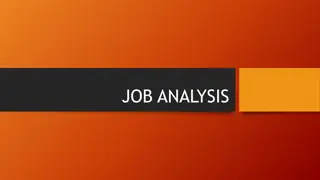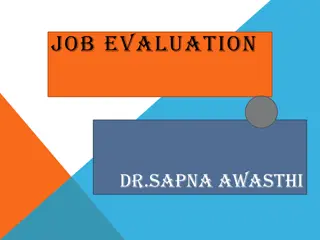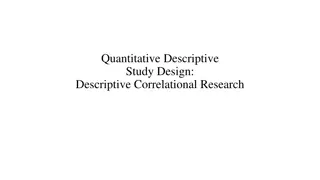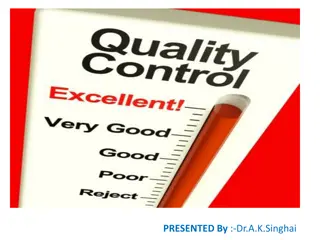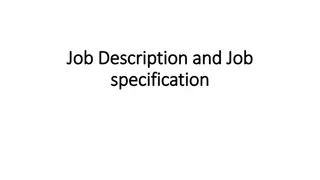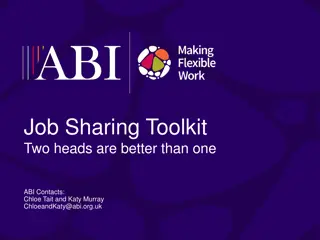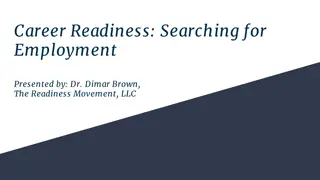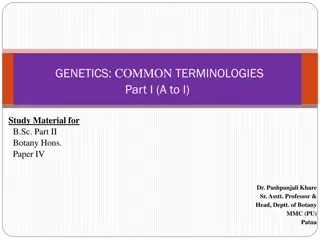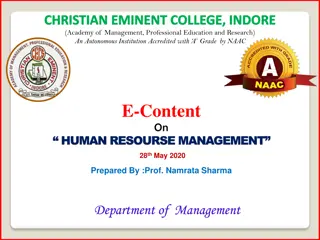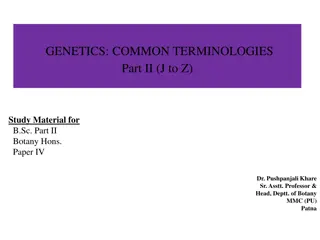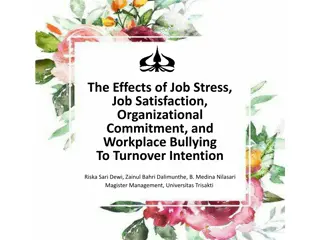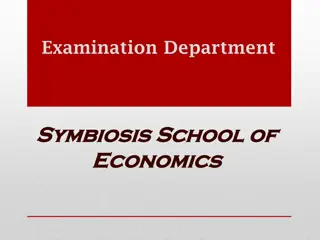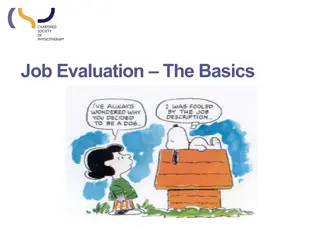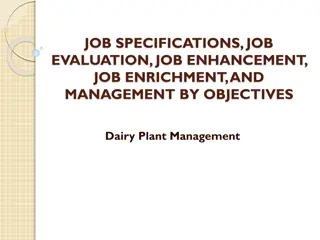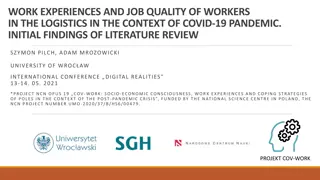Understanding Job Analysis and Design Terminologies
Job analysis involves analyzing tasks, duties, and responsibilities to achieve organizational goals. It includes defining job terminologies like job, duty, task, position, and job title. Reflect on the numbers of jobs and work positions in a department setting. Know when and who performs job analysis, and sources of data for conducting job analysis.
Download Presentation

Please find below an Image/Link to download the presentation.
The content on the website is provided AS IS for your information and personal use only. It may not be sold, licensed, or shared on other websites without obtaining consent from the author. Download presentation by click this link. If you encounter any issues during the download, it is possible that the publisher has removed the file from their server.
E N D
Presentation Transcript
JOB ANALYSIS AND DESIGN CHAPTER THREE
JOB ANALYSIS TERMINOLOGIES Job: a group of tasks, duties and responsibilities that need to be performed to achieve the organization s goal. Duty: a larger work segments composed of several tasks performed by an individual. Task: is the smallest units of analysis or identifiable work activities composed of motions. Position: a collection of task ,duties and responsibilities performed by one person. Job title: brief description of a job, it also Indicate the relative level of the jobholder
REFLECTION In a work unit/department consisting of a department head, two senior analysts, one secretary what are the numbers of jobs and work positions?
JOB ANALYSIS TERMINOLOGIES Note: Job may require a service of one or more person Example: Human resource manager service of one person Human resource expert service of more than one person Position require the service of only one person
DEFINITION OF JOB ANALYSIS Systematic process of determining Duties, Skills, & Knowledge required for performing a job. Job analysis is the process of determining the work activities and requirements, systematic process of collecting information about all of the parameters of a job: basic responsibilities, Required behaviors, skills, and the physical and mental requirements of the people who do it.
WHEN TO CONDUCT JOB ANALYSIS During establishment of organizations when new jobs are created when jobs are changed significantly
WHO PERFORMS JOB ANALYSIS HRM department Manager External consultant
SOURCE OF DATA FOR JOB ANALYSIS Jobholder Immediate supervisor/manager Diaries- Jobholders will record information about their job for some specific period. Secondary data (old job description, specifications, Films of workers on the job, reports etc )
JOB ANALYSIS METHODS Questionnaire Structured questionnaires given to employees to be filled by both jobholder and immediate supervisor. Saves time and is economical However, employees might exaggerate the significance of their tasks
JOB ANALYSIS METHODS Observation Job analyst learn about the job by observing the jobholder at action Used primarily to gather information on jobs emphasizing manual skills Often insufficient when used alone Difficult when mental skills are dominant in a job
JOB ANALYSIS METHODS Diaries Jobholders will record information about their job for some specific period. Employees describe daily work activities in diary or log Valuable in understanding highly specialized jobs Problem: Employees might exaggerate job importance
JOB ANALYSIS METHODS Interview Interview both employee and supervisor Interview employee first, helping him or her describe duties performed After interviews, analyst normally contacts supervisor for additional information
HOW TO ENSURE DATA CORRECTNESS check with immediate supervisor/manager Ask more than one employee
JOB DESCRIPTIONS AND SPECIFICATIONS A job description- is a written statement about the overall tasks, duties, and responsibilities of a job. ..\sample JD.docx..\ A job specification- is incorporated into the job description document and spells out the minimum acceptable qualifications a person needs to perform a particular job.
CONTENT OF JOB DESCRIPTIONS Need to be clear and specific ,to give direction for the jobholder Job Identification Job title, department, reporting relationship, date analyzed and job number or code Job Statement Brief listing of major job duties or Job summary or concise overview of a job Essential functions Essential functions and responsibilities of a job holder or major duties of a job Job specification job specifications, skills, knowledge and attitude requirements
STEPS IN JOB ANALYSIS 1.Identify the scope of the analysis 2.Review relevant background information such as organizational chart, process chart and old job descriptions in order to understand the general context of the job 3.Select benchmarking jobs 4.Identify source of data and data collection method
STEPS IN JOB ANALYSIS 5. Analyze the job 6. Verify the job analysis information with the worker and immediate supervisor. 7. Develop the job description and job specification.
READING ASSIGNMENT Read about Job design Scott, S. A. & Bohlander , G. W., 2012. Managing human resource.
JOB DESIGN An outgrowth of job analysis that improves jobs through technological and human considerations in order to enhance organization efficiency and employee job satisfaction. Job design specifies the contents, methods and relationships of jobs in order to satisfy work requirements for productivity, efficiency and quality, meet the personal needs of the job holder and thus increase levels of employee engagement. Is about determine the optimal way in which a job should be performed.
MAJOR ELEMENTS OF JOB DESIGN Aligning jobs with organizational objectives Consideration of Technological to increase job efficiency Ergonomics concerns- which refers to the process of studying and designing equipment and systems that are easy and efficient for people to use and that ensure their physical well-being. Behavioral concerns that influence an employee s job satisfaction.
JOB DESIGN THEORY Scientific management theory focused on the belief that making people work as hard as they could was not as efficient as optimizing the way the work was done. Job characteristics model A job design theory that significances that three psychological states (experiencing meaningfulness of the work performed, responsibility for work outcomes, and knowledge of the results of the work performed) of a jobholder result in improved work performance, internal motivation, and lower absenteeism and turnover.
JOB CHARACTERISTICS THAT LEAD TO THREE PSYCHOLOGICAL STATES ARE: Skill variety: The degree to which a job entails a variety of different activities, which demand the use of a number of different skills and talents by the jobholder Task identity: The degree to which the job requires completion of a whole and identifiable piece of work, that is, doing a job from beginning to end with a visible outcome Task significance: The degree to which the job has a substantial impact on the lives or work of other people, whether in the immediate organization or in the external environment
THE FIVE JOB CHARACTERISTICS THAT LEAD TO THREE PSYCHOLOGICAL STATES ARE: Autonomy: The degree to which the job provides substantial freedom, independence, and discretion to the individual in scheduling the work and in determining the procedures to be used in carrying it out Feedback: The degree to which carrying out the work activities required by the job results in the individual being given direct and clear information about the effectiveness of his or her performance
JOB DESIGN TECHNIQUES Job enlargement The process of adding a greater variety of tasks to a job. Horizontal expansion. Job rotation The process whereby employees rotate in and out of different jobs. job enrichment Enhancing a job by adding more meaningful tasks and duties to make the work more rewarding or satisfying. Vertical expansion. Employee empowerment Granting employees power to initiate change, thereby encouraging them to take charge of what they do
EMPOWERING EMPLOYEES THROUGH: 1. Participation 2. Innovation: encouraging people to explore new paths 3. Access to information 4. Accountability
JOB DESIGN TECHNIQUES job crafting A naturally occurring phenomenon whereby employees mold their tasks to fit their individual strengths, passions, and motives better Dejobbing refers to a process of structuring organizations not around jobs but around projects that are constantly changing.
WORK SCHEDULES AND CONDITIONS FLEXIBLE WORK SCHEDULES Flextime - give employees the option to choose daily starting and finishing time provided that they work a set number of hours per day or week. Compressed Workweek -the number of days in the workweek is shortened by lengthening the number of hours worked per day.
WORK SCHEDULES AND CONDITIONS WORKING CONDITIONS Job Sharing - an arrangement to share a job between employees. TELECOMMUTING Use of personal computers, networks, and other communications technology such as fax machines to do work in the home that is traditionally done in the workplace.
DISCUSSION Discuss advantages of Telecommuting.



